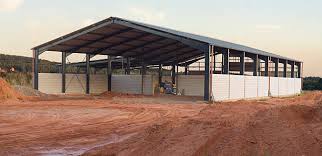FARM STRUCTURE AND BUILDING
Farm Structures
Farm structures are facilities and installations on a farm that support
various agricultural activities. These structures are integral to the efficient
functioning of a farm, providing the necessary infrastructure for storage,
housing, processing, and field operations.
types of farm structures
- Barns: Used for storing hay, grain, and housing livestock.
- Grain Silos : Tall structures for storing bulk grain.
- Greenhouses : Enclosed structures for growing plants under controlled conditions.
- Chicken Coops : Small buildings designed for keeping poultry.
- Dairy Sheds : Facilities for milking cows and storing milk.
- Piggeries: Buildings designed specifically for raising pigs.
- Cold Storage Units : Refrigerated facilities for storing perishable products.
- Machinery Sheds : Structures for storing and protecting farm equipment and machinery.
- Packing Sheds : Buildings for sorting, packing, and processing produce.
- Brooder Houses : Structures for raising young poultry in controlled environments.
Uses of farm structures
-
Safely store crops, feed, and equipment.
- Shelter livestock and provide suitable living conditions.
- Facilitate sorting, packing, and processing of agricultural products.
- Provide space for repairing and maintaining machinery.
- Support controlled environment farming, such as in greenhouses and shade houses.
- Install infrastructure to efficiently water crops.
- Safeguard crops, animals, and equipment from weather and pests.
- Enhance the safety of farm workers by providing appropriate operational spaces.
- Streamline and hygienically manage the milking process in dairy operations.
- Isolate sick animals to prevent the spread of diseases.
Farm building
Farm buildings can be define as specific types of structures on a farm that serve
various purposes related to agricultural operations. These buildings are essential for housing animals, storing crops and equipment, processing
agricultural products, and providing shelter for farm workers.
TYPES OF FARM BUILDING
- Barns : Used for storing hay, grain, livestock, and equipment.
- Farmhouses : Residential buildings where farm owners or workers live.
- Dairy Barns : Specialized barns equipped for housing and milking dairy cows.
- Machinery Sheds : Buildings for storing tractors, plows, and other farm machinery.
- Chicken Coops : Small buildings designed specifically for housing poultry.
Uses of farm building
- Keep hay, grain, and farm equipment protected from the elements.
- Provide shelter and living space for livestock like cows, horses, and chickens.
- House farm owners, managers, and workers in farmhouses.
- Facilitate milking and milk storage in dairy barns.
- Sort, pack, and sometimes process agricultural products in dedicated sheds.
- Provide space for repairing and maintaining farm machinery.
- Isolate and care for sick or injured animals to prevent disease spread.
- Store animal feed to keep it dry and protected from pests.
- Offer a place for carpentry, welding, and other farm-related projects.
- Serve as farm shops or markets where farm products can be sold directly to consumers.


